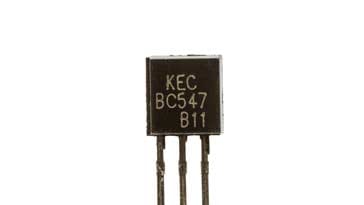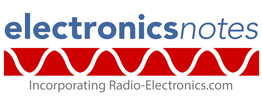The Early Effect in Bipolar Transistors: A 101 Overview
The Early Effect occurs in bipolar transistors and is the variation in the effective width of the base arising from changes in the base-to-collector voltage.
Home » Electronic components » this page
Transistor Tutorial Includes:
Transistor basics
Gain: Hfe, hfe & Beta
Transistor specifications
BJT Early Effect
Transistor and diode numbering codes
Choosing replacement transistors
The Early Effect, also known as base width modulation, is a phenomenon observed in bipolar junction transistors (BJTs) that significantly influences their behaviour, particularly at higher collector-emitter voltages.
The effect is not widely known, but can significantly affect the performance of bipolar transistors in a number of applications and circuit design.

Bipolar Junction Transistor Fundamentals
Before exploring the Early effect, it's crucial to understand the basic operation of a BJT. A BJT is a three-terminal semiconductor device consisting of three doped regions:
Emitter: Heavily doped with majority carriers (electrons for an NPN transistor).
Base: Lightly doped with minority carriers.
Collector: Moderately doped with majority carriers.

In the forward-active region, the emitter-base junction is forward-biased, while the collector-base junction is reverse-biased. This creates a narrow depletion region at the collector-base junction, effectively isolating the collector from the base.
The Physics of the Early Effect
The early effect arises from the widening of the collector-base depletion region as the collector-emitter voltage (VCE) increases.
This widening occurs due to the following:
Reverse Bias: The reverse bias across the collector-base junction creates an electric field that repels majority carriers in the collector.
Depletion Region Expansion: As VCE increases, the reverse bias across the collector-base junction also increases. This stronger electric field extends the depletion region deeper into the base region.
Effective Base Width Reduction: The widening of the depletion region effectively reduces the width of the neutral base region. This reduction in base width has a significant impact on transistor characteristics.
Impact of the Early Effect on Transistor Characteristics
The early effect has several key consequences on the behavior of a BJT:
Collector Current Increase: As the base width decreases, the probability of minority carriers (electrons for NPN) injected from the emitter reaching the collector increases. This leads to an increase in the collector current (IC) for a given base current (IB).
Output Resistance Reduction: The early effect results in a decrease in the output resistance of the BJT. Output resistance (ro) is defined as the change in collector-emitter voltage (VCE) divided by the change in collector current (IC) at constant base current (IB). A lower output resistance implies that the collector current is more sensitive to changes in collector-emitter voltage.
Early Voltage (VA): The early voltage (VA) is a parameter that characterizes the magnitude of the early effect. It is defined as the extrapolated voltage at which the collector current theoretically becomes infinite.
A higher Early voltage indicates a weaker early effect.
The output conductance (go) is the reciprocal of the output resistance. It represents the change in collector current per unit change in collector-emitter voltage. The early effect increases the output conductance of the BJT.
Implications for Circuit Design
The early effect has significant implications for the design of BJT-based circuits:
Current Gain Variation: The increase in collector current due to the early effect can lead to variations in the current gain (β) of the transistor. This can affect the performance of circuits that rely on a constant current gain, such as amplifiers.
Output Impedance: The reduction in output resistance due to the early effect can impact the overall output impedance of circuits. This is particularly important in circuits that drive low-impedance loads.
Circuit Stability: The early effect can contribute to feedback effects in circuits, potentially leading to instability. Careful circuit design is necessary to mitigate these effects.
Techniques to Mitigate the Early Effect
Several techniques can be employed to minimize the impact of the early effect:
Cascode Configuration: The cascode configuration is a common technique that uses two transistors in series. The first transistor operates as a common-emitter amplifier, while the second transistor operates as a common-base amplifier. The common-base stage provides a high output impedance, which helps to reduce the impact of the early effect.
Current Mirrors: Current mirrors are circuits that generate a replica of a given current. By using transistors with high early voltages, current mirrors can be designed to be less sensitive to variations in collector-emitter voltage.
Feedback Techniques: Feedback techniques can be used to stabilize circuit performance and reduce the impact of variations caused by the early effect.
The early effect is an inherent characteristic of bipolar junction transistors that influences their behavior significantly. Understanding the underlying physics and its impact on transistor characteristics is crucial for the successful design of BJT-based circuits. By employing appropriate techniques, such as cascode configurations and feedback, the effects of base width modulation can be mitigated, leading to improved circuit performance and stability.
 Written by Ian Poole .
Written by Ian Poole .
Experienced electronics engineer and author.
More Electronic Components:
Batteries
Capacitors
Connectors
ADC
DAC
Diodes
FET
Inductors
Memory types
Phototransistor
Quartz crystals
Relays
Resistors
RF connectors
Switches
Surface mount technology
Thyristor
Transformers
Transistor
Unijunction
Valves / Tubes
Return to Components menu . . .


